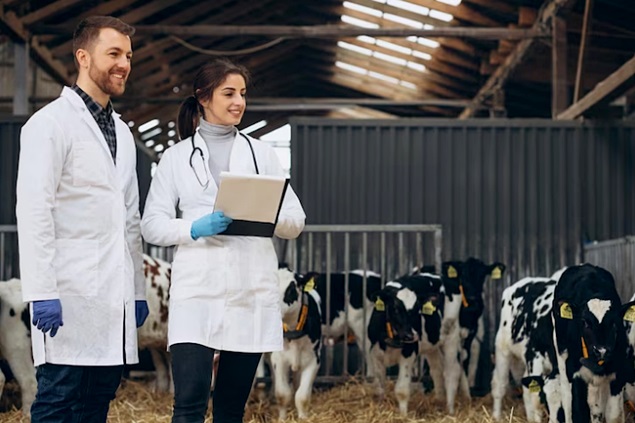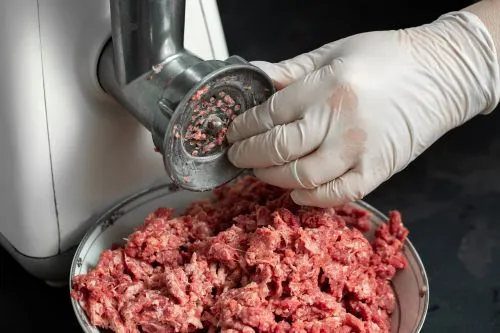
IoT devices can accurately assess inputs and manage dairy farms in real-time, improving accuracy and saving time for farmers, according to an analysis by DairyGlobal.
The New Tools
Some visible examples of this in our dairy industry are the millions of wearable devices such as collars and tags.
Robots, the Internet of Things (IoT), and Artificial Intelligence (AI) are everyday fixtures in hospitals, and this technology is now transforming the dairy products industry.
In the healthcare sector, these innovations were initially met with concerns about job losses but quickly gained widespread acceptance. Now, more dairy farmers are embracing this technology, pushing the dairy products industry into a similar position to where healthcare was years ago.
Dairy farmers have an advantage: by observing the changes in healthcare, dairy farmers can educate and prepare their workforce for an inevitable and uninterrupted agtech revolution.
Robots
At Aalborg University Hospital, robots efficiently transport up to 3,000 blood samples at a stable temperature to ensure accurate analysis and improved patient care. Beyond logistical tasks, a robot named PARO responds to touch and sound to reduce patient stress, anxiety, and loneliness.
Agricultural robots are similarly embraced on the farm. For example, robots can clean barns, feed animals, and even allow cows to choose when to be milked.
AgriTech Capital estimates that over 1 million cows worldwide are milked by robots, and the Dairyland Initiative group found that one robot could handle an average of 53-70 cows.
Internet of Things (IoT)
By providing relevant, real-time data to healthcare professionals, IoT technologies such as smart devices and wearables have transformed hospital staff's work.
These health devices eliminate the need for continuous monitoring, allowing bedside staff to allocate their time to other tasks.
IoT devices are following a similar trend in agribusiness. They can accurately assess inputs and manage dairy farms in real-time, improving accuracy and saving time for farmers.
Some visible examples of this in our dairy products industry are the millions of wearables such as collars and tags, and SmaXtec's smart rumen bolus, the latest technology in the U.S. dairy product market, already used by hundreds of thousands of cows.
The ability to monitor cow movements, productivity, and health before any issues arise can save hundreds of dollars per year for each animal on a dairy farm.
Artificial Intelligence (AI)
Medical errors, costing the healthcare industry $1.9 billion annually and resulting in over 200,000 deaths, are often caused by fatigue, memory loss, lack of experience or training, and misunderstandings.
The use of Artificial Intelligence in healthcare, provided by companies like Google Health and Babylon Health, has already improved disease detection and patient outcome predictions.
How can we avoid mistakes on our farms? AI can help us overcome human errors by accurately analyzing data, forecasting yields, detecting potential health issues, optimizing resource allocation, and connecting decisions to market needs and prices.
AI calculations can also play a key role in addressing carbon credits and resource deficits. Furthermore, big data and cloud computing enable farmers to cope with real challenges due to weather, genetics, market fluctuations, and soil and animal microbiomes.
For example, Ever.Ag is a technology company specializing in dairy products, enabling better real-time decision-making based on market changes with fewer errors.
Lessons for Farmers
In the healthcare field, robots, IoT, and AI have improved the quality of healthcare and replaced jobs, even highly skilled ones. But we still have healthcare professionals; their roles have just changed.
A study by MIT and Brigham and Women's Hospital found that many patients are willing to interact with robots for certain healthcare services but still want human contact for more complex or sensitive issues.
Currently, healthcare jobs are experiencing a 19% job growth and will create over 2.3 million jobs in the next few years—the best employment outlook in any field.
Robots, IoT, and AI are unlikely to replace human workers in healthcare. Instead, they are ready to enhance their skills and allow them to focus on more meaningful tasks.
On the other hand, agricultural employment in the U.S. is expected to grow by only 1%. Even before the agrotechnological revolution, agriculture faced a "people problem" for decades due to low wages and harsh conditions. As the executive search group in agriculture, Kincannon & Reed, puts it, "If it was hard to find good help before, it's even harder now."
What Does This Mean for the Dairy Industry?
Automation will target jobs that people don't want to do. Like the transformation we've seen in healthcare, this technology will pave the way for more stimulating, better-paying work that attracts and retains a flexible workforce.
A McKinsey survey found that over 50% of large farms and nearly a quarter of small farms use (or plan to use) precision agriculture technology, so the demand for highly skilled jobs will only increase.
Future dairy industry workers should be recruited with new skills: data analysis, software engineering, and coding.
A Prosperous Path for the Workforce
In fact, many argue that only AI will lead to long-term job growth by increasing productivity and consumption and creating new categories of human jobs that complement tasks performed by AI systems.
Using robotics, sensors, and artificial intelligence to efficiently, precisely, and profitably grow food not only provides safe and affordable food but also opens a prosperous path for the workforce.
How can dairy farmers cultivate and retain a talented and flexible workforce? As mentioned in my book, "The Future of Agriculture," education and training programs are proven ways to cultivate a workforce that evolves with each innovation.
While companies like Ever.Ag can strengthen top-down agricultural businesses through risk assessment and opportunity capture, companies like Plenty can strengthen bottom-up organizations through employee training.
The dairy products industry could increase productivity and bring new wealth if farmers follow the healthcare industry's example and invest in their workforce.
This technological shift, combined with workforce training, is an opportunity to create a thriving dairy industry that benefits everyone.




